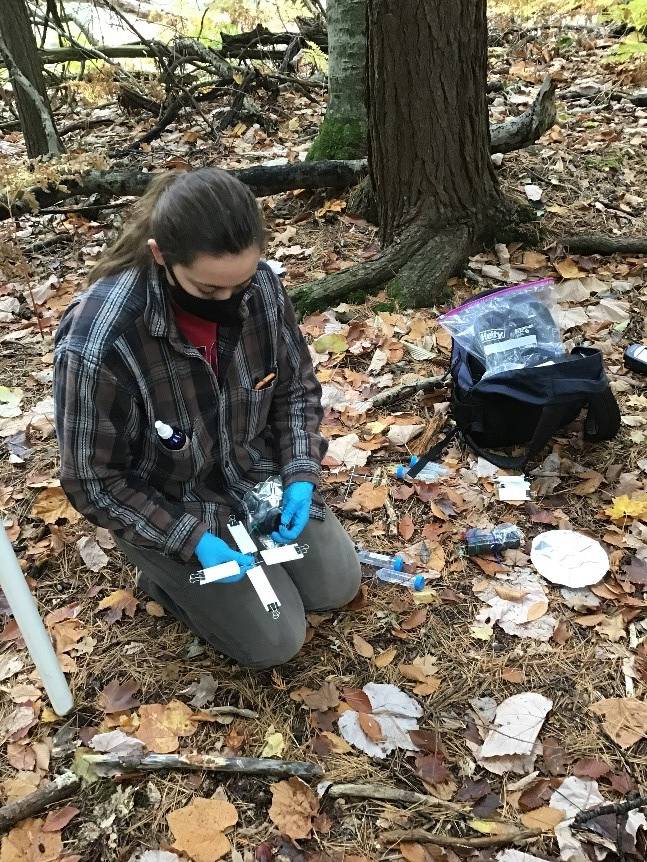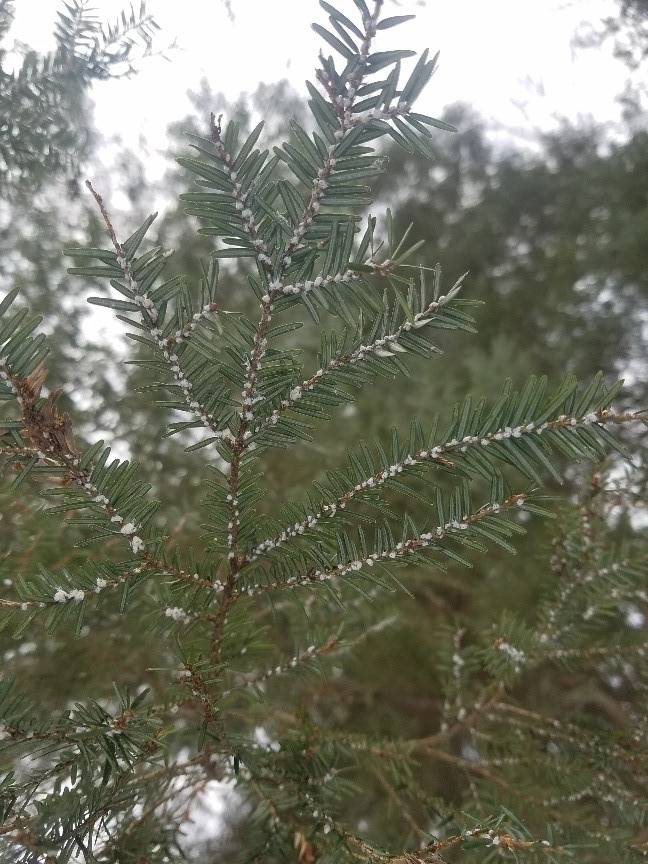#218 September 2021


Pictured left: Graduate student, Meg Sanders, exchanging slides on a trap for eDNA analysis.
Pictured right: Hemlock branch infested with HWA ovisacs (small white balls at the base of the hemlock needles).
HELPING TO MONITOR FOR HEMLOCK WOOLLY ADELGID (HWA) ACROSS MICHIGAN’S COASTAL HEMLOCK FORESTS
Hemlock forests support critical habitat for both terrestrial and aquatic ecosystems. In riparian ecosystems, they shade streams to moderate temperatures, regulate streamflow, and decrease runoff into their surrounding water bodies. This is one of the many reasons why protecting the coastal hemlocks along the Lake Michigan shoreline has become a top priority for many management groups in Michigan. Michigan’s hemlock forests are currently under threat from a tiny invasive insect, hemlock woolly adelgid (Adelges tsugae), otherwise known as HWA. This insect feeds on hemlock nutrients and can kill healthy trees in four to ten years. Dr. Charlyn Partridge (AWRI) and her graduate student, Meg Sanders, along with Dr. Jim McNair (AWRI), Dr. Sean Woznicki (AWRI), and Dr. Alexandra Locher (Biology) are working to develop and assess novel methods that will aid in early detection of HWA. The approach they have developed uses environmental DNA (eDNA), which is genetic material collected from the environment, to help monitor for the presence of HWA within coastal hemlock populations. This spring, Sanders and other members of the Partridge lab, set out 105 of the eDNA traps in North Ottawa Dunes (Ottawa County), and over the course of four months, sampled the traps every other week to evaluate (1) how well the traps were able to capture adelgids, (2) how capture rates varied across the landscape, and (3) how the number of adelgids captured corresponds with distance to an infested hemlock tree. Preliminary analyses indicated that the eDNA traps are highly efficient at capturing HWA, and that the number of adelgids captured per trap may be used to pinpoint infested hemlock stands within an area. This technology could help preserve valuable personnel and financial resources for HWA eradication efforts in Michigan, as well as aid land managers in other states continuously monitoring HWA populations.
Faculty and Staff Activities
AWRI hosted students from the GVSU Frederick Meijer Honors College course, “Design Thinking for Social Product Innovation,” on September 15th. The students toured the labs and the research vessel W. G. Jackson, and learned about AWRI’s mission and history. They also heard presentations from Rick Rediske: “Water treatment considerations for developing countries”, Bopi Biddanda: “Our water planet: Top-down and bottom-up perspectives”, and Christina Catanese: “Art & science collaborations”.
Bopi Biddanda is teaching Environmental Studies 310, How the Biosphere Works this fall semester.
Christina Catanese shared that the fall research vessel season is officially underway on the W. G. Jackson and D. J. Angus as of September 1st. Both boats are running several field trips per week for 4th grade through adults, until the season ends on October 15th.
Sarah Hamsher is teaching Biology 121, General Biology II and BIO 376, Genetics Laboratory this fall.
Jim McNair participated in weekly Zoom meetings with Molly Lane, Rick Rediske, and scientists from US EPA, Michigan EGLE, Michigan State University, and several other Michigan universities regarding a new project dealing with statistical analysis and interpretation of qPCR beach-monitoring data.
Jim McNair is a member of the GVSU CLAS Faculty Development Committee; they met for the first time this academic year on September 16th.
Charlyn Partridge attended weekly Zoom meetings with the MiNET group to discuss the COVID wastewater project and the summer beach sampling project.
Charlyn Partridge met with Matt Cooper from Muskegon Community College (MCC) about ways or potential ways her lab’s sequencing services could be incorporated into labs or student research at MCC on September 3.
Charlyn Partridge is teaching Biology 120, General Biology I Laboratory this fall semester.
Rick Rediske attended a virtual meeting of the Wolverine Community Advisory Group and provided an update on PFAS impacts to the Rogue River on September 16th.
Carl Ruetz is teaching Biology 362, Biology & Diversity of Fishes, this fall semester.
Carl Ruetz has agreed to serve as a representative for the Society of Freshwater Science on the local arrangements committee for planning of the Joint Aquatic Sciences Meeting in Grand Rapids in 2022.
Al Steinman met as part of a subgroup of the National Academy of Sciences committee evaluating Everglades Restoration progress, to discuss performance of the STAs (Stormwater Treatment Areas) treating runoff from the sugar cane farms. Other members of the subgroup include Charlie Driscoll (Syracuse U.), Bill Boggess (Oregon State U.), and Ramesh Reddy (U. of Florida). Al will also be leading a subgroup reviewing the new Lake Okeechobee Schedule Operating Manual (LOSOM) proposed by the U.S. Army Corps of Engineers.
Al Steinman attended regular monthly meetings with the Boards of Goodwill of West Michigan and the West Michigan Symphony.
Kevin Strychar is teaching Biology 105, Environmental Science this fall semester.
Amanda Syers is serving as a reviewer for the Michigan Environmental Education Curriculum Support (MEECS) ecosystems unit.
Janet Vail is teaching three GVSU courses this semester: Environmental Studies 183, Sustainability as a Life Style with Amanda Syers; Environmental Studies 201, Introduction to Environmental and Sustainability Studies; and Science 225, Integrated Life Science for PK-3 Teachers.
Presentations and Publications
AWRI staff are bolded, undergraduate students are denoted with a single asterisk*, graduate students are denoted with two asterisks**, and post-doc researchers are donated with three asterisks ***.
PRESENTATIONS
Bopi Biddanda was an invited speaker for a seminar at Hope College on September 24th. The title of his presentation was: “From sinkholes to biosphere and beyond”.
Kelsey Inman-Carter, Sarah Hamsher’s student summer scholar intern, presented her research entitled, “The epiphytic diatom community of an invasive macroalga, starry stonewort (Charales: Nitellopsis obtusa) and its native relative, Chara contraria (Charales) from two drowned river mouth lakes in Michigan” at the GVSU Summer Scholars Showcase held on September 9th.
Janet Vail gave a presentation on Climate Change 101 for WMEAC’s “Climate Change for Candidates” online event on September 23rd.
Sean Woznicki was a guest lecturer for EPA Region 5 Source Water Protection group on September 17th. His presentation was titled: “Projecting the impacts of landcover change on drinking water treatment”. Attendees included EPA employees and Region 5 state environmental agencies (Michigan, Ohio, Indiana, Illinois, Wisconsin, Minnesota).
PUBLICATIONS
Bopi Biddanda was lead author on an article published in the journal Life:
Biddanda, B.A., A. Weinke, I. Stone*, S. Kendall, P. Hartmeyer, W. Lusardi, S. Gandulla, J. Bright and S. Ruberg. 2021. Extant earthly microbial mats and microbialites as models for exploration of life in extraterrestrial mat worlds. Life, Special issue on Microbial Life in the Solar System. Life 11(9), 883. https://doi.org/10.3390/life11090883
Bopi Biddanda was lead author of an article in the online (non-peer-reviewed) Encyclopedia:
Biddanda, B., A. Weinke, I. Stone*, S. Kendall, and S. Gandulla. 2021. Microbial mats: Extraterrestrial life models. Encyclopedia. https://encyclopedia.pub/15065
Jasmine Mancuso, recent graduate student who worked with Bopi Biddanda, had two articles published this month:
Mancuso, L.J.**, A.D. Weinke, I.P. Stone*, S.E. Hamsher, M. Villar-Argaiz and B.A. Biddanda. 2021. Cold and wet: Diatoms dominate the phytoplankton community in a year of anomalous weather in a Great Lakes estuary. Journal of Great Lakes Research. https://doi.org/10.1016/j.jglr.2021.07.003
Mancuso, L.J.**, A.D. Weinke, I.P. Stone*, S.E. Hamsher, M.M. Woller-Skar, E.B. Snyder, and B.A. Biddanda. 2021. Bloom and bust: Historical trends of harmful algal blooms in Muskegon Lake, Michigan, a Great Lakes estuary. Freshwater Science. https://www.journals.uchicago.edu/doi/full/10.1086/716236
Lidiia Iavorivska, former postdoc in Al Steinman’s lab, and Al are authors on an article accepted for publication:
Iavorivska, L., Veith, T.L., Cibin, R., Preisendanz, H.E., and A.D. Steinman. In Press. Mitigating lake eutrophication through stakeholder-driven hydrologic modeling of agricultural conservation practices: A case study of Lake Macatawa, Michigan. Journal of Great Lakes Research.
Grants, Contracts, Awards, and Recognition
GRANTS & CONTRACTS
No new grants or contracts this month.
AWARDS & RECOGNITION
No awards or recognitions this month.
AWRI News and Events
“Lake Huron sinkhole may hold secrets to how Earth got its oxygen”
Fox 2 Detroit, September 1, 2021
Bopi is one of the researchers involved in this Lake Huron sinkhole/microbial mats project.
Also carried by Fox 29 Philadelphia
“What tells us about the rotation of the earth and the origin of oxygen in a lake – -04/09/2021”
The Press Stories (Presstories.com), September 4, 2021
GVSU-AWRI is mentioned in this article; Bopi is one of the researchers involved in this Lake Huron sinkhole/microbial mats project.
“We’re eating and drinking Great Lakes plastic. How alarmed should we be?”
MLive, September 9, 2021
Al Steinman was quoted in this article discussing microplastics in drinking water. Al was the lead on a recent microplastics study done in Muskegon Lake.
Also carried by newsbinding on September 11, 2021
“As drought grips American West, irrigation becomes selling point for Michigan”
circleofblue.org, September 27, 2021
Al Steinman is quoted regarding the Water Withdrawal Assessment Tool; he was a member of the team that developed this tool.
Also carried by: Bridge Michigan and Michigan Radio
“$150 million aquarium could be built in Muskegon or Kent County by John Ball Zoo”
MLive, September 29, 2021
AWRI is mentioned in the article as it is already in Muskegon, and doing water research.
LMC EVENTS
Dr. Jeffrey Heilveil (State University of New York; College at Oneonta), presented "Understanding Population Structure: The need for basic life history information" at the LMC on September 10th.

